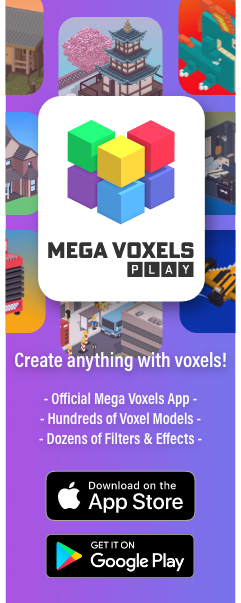How to Export from VoxEdit
VoxEdit offers lots of different export options that you can use in your games and projects. In this tutorial, you will learn how to export voxel models from VoxEdit.
So you finally finished your very own voxel model inside of VoxEdit and you're ready to use your 3D model in your next big project. Of course the question is, how do I export from VoxEdit? The nice thing about VoxEdit is that it comes with many different export options that you can use for a variety of scenarios. We'll be covering the different options below depending on what you plan to use your voxel model for. But first we will show you how to view the export options inside of VoxEdit.
These are the Export formats supported by VoxEdit:
After you click that option, a new save file dialogue will appear that will allow you to save your OBJ model to your machine. Give it a name and click Save.
If you have any question or comments please leave them below. Thanks for reading.
So you finally finished your very own voxel model inside of VoxEdit and you're ready to use your 3D model in your next big project. Of course the question is, how do I export from VoxEdit? The nice thing about VoxEdit is that it comes with many different export options that you can use for a variety of scenarios. We'll be covering the different options below depending on what you plan to use your voxel model for. But first we will show you how to view the export options inside of VoxEdit.
To learn more about all the features VoxEdit has to offer, check out VoxEdit Voxel Editor
How to See the Export Options for VoxEdit
To see the export options inside of VoxEdit, begin by opening your current voxel model or a new voxel model.Once you have opened a model inside of VoxEdit all export options will be available to you. To view the Export options inside of VoxEdit click File > Export to view the different formats.
These are the Export formats supported by VoxEdit:
- VXR - Skeleton file for rigging and animation
- OBJ - Wavefront 3D Model File Format supported by most 3D software
- DAE - Collada 3D File Format
- GLTF - GL Transmission Format
- Export to Marketplace - Export your model to the Sandbox Marketplace
- PNG - 2D Bitmap image (Accessed via Camera Icon at bottom of editor)
Sponsored Ad
Choosing the Right Export Option
As you can see from the previous list, no matter what kind of scenario you are currently working in, VoxEdit has some great export formats to work with. However depending on the type of project, one format might make more sense than others. For example if you are a game developer that needs to put your voxel model into a game engine software such as Unity or Unreal, you will need to use the OBJ or DAE 3D file formats as these are heavily supported by game engines. If you plan on selling your own voxel models on the SandBox Marketplace you will need to select the Export to Marketplace option to make your models available to users. And lastly if you need your model in a 2D format for social media or the web, you can use Screenshot option to create a 2D image of your model.
How to Export a .OBJ Model from VoxEdit
As we mentioned before, if you plan on using your voxel model in a game or farther modifying it in a 3D modeling software then OBJ is your best option inside of VoxEdit. To export a voxel model from the VoxEdit editor as an 3D .obj file, click the File button located at the top, then click the Export button to view the Export options and lastly click Export OBJ.After you click that option, a new save file dialogue will appear that will allow you to save your OBJ model to your machine. Give it a name and click Save.
This is a great option for game developers, as the .obj file format is widely supported in popular game engines such as Unity and Unreal. Bare in mind this will also create a .PNG file and a . MTL file along with the .OBJ file. This is good to remember because if you don't include these files in your project, your model will most likely look gray or white and you won't be able to see any texture on your model.
Sponsored Ad
How to Export a .PNG Image from VoxEdit
If you plan on sharing your voxel art on social media or a website you're going to have use a file format that they accept which is usually a Bitmap image. As of right now you can't use a .OBJ or .DAE file for sharing to the web, however you can use an image file such as .JPG or .PNG. VoxEdit has a screenshot option for exporting a 2D image of your model. To export your voxel model as a PNG image click the camera button located at the bottom left of the editor.
Sponsored Ad
If you have any question or comments please leave them below. Thanks for reading.
Learn how to use MagicaVoxel by visiting our free MagicaVoxel Tutorials







Comments
Post a Comment